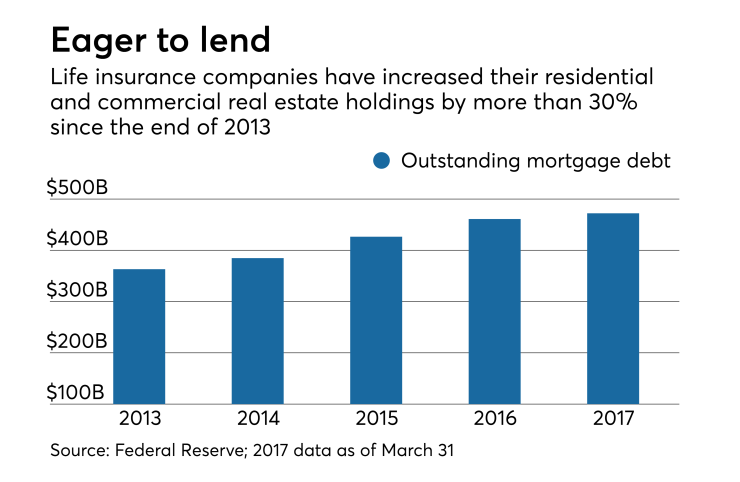Life insurance companies are trying to chip away at banks’ dominant market share in commercial real estate lending.
Though commercial banks still hold more than half the outstanding debt on CRE and multifamily loans, life insurers have largely kept pace in recent years and last quarter even outpaced banks in originations, according to data released Tuesday by the Mortgage Bankers Association.
Life insurers originated 25% more CRE and multifamily loans last quarter than in the first quarter, while commercial banks' volume was down 5% from the prior quarter and 21% year over year, according to the MBA.
Don’t think banks haven’t noticed. In a recent conference call to discuss second-quarter earnings, BankUnited President and CEO Rajinder Singh cited competition from life insurance companies as a key reason the Miami Lakes, Fla., bank is scaling back in multifamily lending.
“Increasingly, we're seeing competition from … life insurance companies,” Singh said. Along with government-sponsored lenders and conduits, “we saw life insurance companies really dominating the market” last quarter, he said.

The life insurance industry’s ramp-up in multifamily is part of a broader expansion in real estate lending. According to the Federal Reserve, life insurance companies held around $472.2 billion in total mortgage debt, including residential loans, in the first quarter, a 30% increase in volume since 2013. While that’s just 3.2% of the overall market, it is up from 2.7% at the end of 2013. Life insurers' share of the CRE and multifamily market stood at 11.3% on March 31, up from 10.7% in 2013.
Life insurance companies like real estate for the same reason any other investors do. They have long-term liabilities to fund (i.e., death benefits) and though they invest mostly in bonds, they see real estate as a safe alternative that can provide steady returns. Those lenders can include some of the biggest and best-known names, like MetLife, Prudential and Northwestern Mutual, and notoriously, they tend not to compromise on credit quality.
Because they can typically offer a better long-term rate to a borrower, life insurance companies compete for only the very best credits, and they can often offer more competitive rates for those high-quality deals in top markets, said Matt Anderson, a managing director at the New York-based analytics firm Trepp.
Anderson said that life insurers’ interest in real estate tends to ebb and flow, depending on market conditions. With interest rates rising and banks being under some pressure from regulators to scale back their exposure to commercial real estate, life insurers are seeing “a bit of opportunity” to steal some market share from banks, Anderson said.
Multifamily seems to be a particularly attractive market for life insurers these days. Life insurance companies held around $68.5 billion in outstanding multifamily debt in the first quarter, up nearly 28% from the end of 2013.
Multifamily loans have performed well for life insurance companies, said Jamie Woodwell, vice president of commercial real estate research at the Mortgage Bankers Association.
“The performance of multifamily loans has really been extraordinary of late,” he said. “If you look at life [insurance] companies, the delinquency rate on multifamily mortgages is zero. … It’s hard to fathom that they could be performing any better they are.”
Woodwell said that while banks are increasing their holdings of multifamily mortgages, they are doing so at a slower pace than insurers. In the first quarter, multifamily mortgage debt held by insurers increased by 2.4% from the fourth quarter of 2016, compared with the 2% growth at banks and thrifts and 3.6% growth at government-sponsored entities and other agency lenders.
At BankUnited, multifamily loans made up 18.4% of total loans at June 30, down from 19.8% at the end of 2016 and 20.3% on June 30 of last year. In the conference call with analyst, Singh said regulatory scrutiny of banks is opening the door a bit for life insurers and other lenders. He said regulators aren’t as worried about the underlying fundamentals of the multifamily market as they are about borrowers' ability to refinance when interest rates have risen.
“In a rising rate environment, regulators are concerned that those [capitalization] rates are going to come down," Singh said. "And if those cap rates come down, they will create credit risk at the time of maturity of these loans. Two years down the road, when a loan has reached its five-year mark, it will be very difficult to refinance that loan. That's what their concern is. And it's a new kind of concern.”




